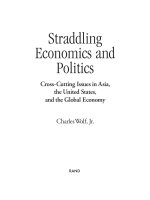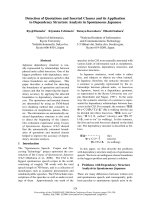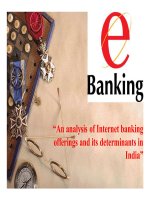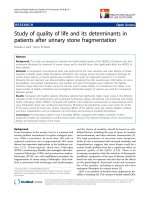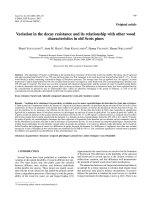Acquirer performance and its determinants testing cross border ma in asia
Bạn đang xem bản rút gọn của tài liệu. Xem và tải ngay bản đầy đủ của tài liệu tại đây (442.19 KB, 96 trang )
ACQUIRER PERFORMANCE AND ITS
DETERMINANTS: TESTING CROSS-BORDER M&A
IN ASIA
XIAO WEI YUN
(M.S.c NUS)
A THESIS SUBMITTED
FOR THE DEGREE OF MASTER OF SCIENCE IN
MANAGEMENT
DEPARTMENT OF BUSINESS POLICY
NATIONAL UNIVERSITY OF SINGAPORE
2004
- i -
ACKNOWLEDGEMENTS
My foremost thank goes to my supervisor, Associate Professor Andrew Delios. I
thank him for his insightful advice and timely encouragement, which have made this
thesis possible. His professional experiences in research and seasoned guidance in
supervision have made this study a pleasant journey.
I am grateful to the committee members of my thesis proposal: Associate
Professor Nitin Pangarkar, Associate Professor Rachel Davis, and Dr Chung Chi Nien.
They provided me many insightful comments and suggestions on my thesis proposal,
and helped me to improve my thesis in many aspects.
I would also like to thank the Faculty of Business Policy. I thank Dr Jane Lu for
her enlightenment on doing research; I thank Associate Professor Peter Hwang for his
training on our critical thinking. I am also grateful to my colleagues: Lihong Qian,
Kong Chung Chan, Ajai Singh Gaur, Zhijian Wu, Gang Li, Chang Ge, Weiting Zheng,
Sien Shen. I thank them for their constant support and encouragement. I also
appreciate the assistance from Teo Woo Kim and Wendy Ng.
Last but not least, I am deeply indebted to my dear parents and all my other
family members. Their selfless sacrifice, tender care and constant support in all these
past years are the biggest encouragement for me to seek my goal in the academic
field.
Xiao Weiyun
October 28, 2004
- ii -
TABLE OF CONTENTS
CHAPTER 1 INTRODUCTION 1
1.1 Background 1
1.2 Contributions 4
1.3 Findings 5
1.4 Organization 6
CHAPTER 2 LITERATURE REVIEW 8
2.1 Why do firms undertake M&As? 9
2.1.1 Hypotheses about M&As driven by value-increasing motives 10
2.1.2 Hypotheses about non-value-increasing motivations 13
2.2 M&A Performance 14
2.2.1 Outcome studies 15
2.2.2 Event studies 17
2.3 The limitations in the existing literature of M&A 19
2.3.1 The literature on determinants of M&A performance 20
2.3.2 M&As in Asia 22
2.4 Summary 23
CHAPTER 3 HYPOTHESES DEVELOPMENT 24
3.1 Factors influencing value creation 26
3.1.1 Ownership advantages of the acquiring firm 26
3.1.2 Business relatedness between acquiring and target firms 28
3.1.3 Interaction between the relatedness and ownership advantages 31
3.2 Factors influencing the cost of M&A 32
3.2.1 Acquirer’s knowledge about target firm prior to the acquisition 32
3.2.2 Prior organizational acquisition experience 34
3.3 Summary 35
CHAPTER 4 RESEARCH DESIGN 36
4.1 Setting 36
4.2 Sample 36
4.3 Model and measures 40
4.3.1 Cumulative abnormal returns 42
4.3.2 Ownership advantages 44
4.3.3 Business relatedness between acquiring and target firm 45
4.3.4 Interaction between ownership advantages and business relatedness 45
4.3.5 Acquirer’s knowledge about target firm 46
4.3.6 Prior acquisition experience 46
4.3.7 Control variables 47
CHAPTER 5 RESULTS 49
5.1 Acquirer performance 49
5.1.1 Z test on the entire sample 49
5.1.2 Z test on subsamples 50
5.2 Influential factors of acquirer performance 50
5.2.1 Findings on entire sample 51
- iii -
5.2.2 Findings on Asia acquirers 53
5.2.3 Findings on U.S. acquirers 54
5.3 Summary 55
CHAPTER 6 DISCUSSION & CONCLUSION 57
6.1 Ownership advantage & its interaction with business relatedness 58
6.2 Related and unrelated M&As 63
6.3 Acquirer’s knowledge about target prior to the acquisition 65
6.4 Organizational acquisition experience 66
6.5 Limitations and future research directions 68
6.6 Conclusion 70
BIBLIOGRAPHY 71
- iv -
SUMMARY
This thesis investigates two research questions: 1) whether acquiring firms win or lose
in the cross-border M&As in Asia; and 2) what are the factors that influence acquirer
performance.
Answering the call for understanding the performance of M&As undertaken
outside U.S. or Europe, I use the standard event-study approach to examine stock
returns to those acquiring firms taking over Asian targets. Further, to explore the
factors influencing acquirer performance, I adopt the following underlying logic.
Performance of M&As on the stock market depends upon market’s valuation of the
net present value (NPV) of M&A transactions. As the NPV of an M&A is decided by
two parts, value created by the transaction and the cost of this investment, I transform
the research question into identifying the factors that influence the realization of value
creation and the factors that determine the investment cost of an M&A transaction.
In M&As, value creation is a process which involves combining and making
optimal use of two merging firms’ specialized resources (technology, production,
marketing, finance, human resource, etc.). Therefore, I expect that the achievement of
value creation is highly related to two factors: 1) resources that are productive and
transferable within the M&A; and 2) the conditions for combination and
reconfiguration of such resources. Accordingly, I predict that stock market
performance of the acquiring firm in an M&A would be influenced by acquirer’s
ownership advantages, business relatedness between acquiring and target firm, and
- v -
the interaction between business relatedness and ownership advantages.
Cost of M&A is the other side of the coin. An M&A investment can be
considered as a process involving searching and valuing targets, negotiation,
execution and integration; accordingly, I break the cost of such investment into three
parts: searching and valuing cost, negotiation cost and premium paid, and integration
cost. I expect that liabilities of foreignness increase M&A cost, while prior M&A
experience could help the acquiring firms to save the time, effort, money, or other
resources involved in M&A activities, which in turn reduces the M&A cost.
I test my five hypotheses by using a sample of 314 cross-border acquisitions
undertaken during 1985-1999, 57% of which was conducted during 1997-1999. These
314 international transactions were made by 246 acquiring firms from the U.S., Hong
Kong and Singapore. The U.S. firms seem to be the most active acquirer in my
sample; more than half (60.83%) of the transactions were conducted by firms from
the United States. On the target side, the 314 transactions cover 11 Asian countries, of
which China, Hong Kong, Malaysia, and Singapore had aggregately received 69.11%
of the total investment. Further, the data also indicates that Hong Kong, China and
South Korea are the most popular destinations for FDI in the sectors of electronic
equipment, chemical, printing and etc. U.S. acquirers appear to be more interested in
conducting related M&As than their Asian counterparts.
The Patell Z tests in this study show that on average, acquirers earn insignificant
abnormal returns from cross-border M&As in Asia. Z Tests on the subsamples of
acquirers from different origins find that only the shareholders of U.S. acquiring firms
- vi -
enjoy significant, but small positive excess returns from the acquisition; but no
significant abnormal returns are found among Asian acquirers.
The results for OLS regressions support part of the hypotheses. Specifically,
acquiring firms with superior intangible assets would enjoy better performance;
related M&As could generate more benefits than unrelated M&As for acquirers; and
there exists a significant U-shape relationship between acquirer performance and
acquisition experience. On the other hand, the positive effect of intangible assets on
acquirer performance seems to be weakened in related M&As. In addition, the study
does not find a significant relationship between acquirer performance and acquirer’s
knowledge of the target.
Combining the empirical results with theoretical arguments, I discuss
explanations for the unexpected findings and interpretations for the supported results.
Potential improvement in both theoretical and empirical aspects is also addressed.
- A -
Table 2-1 Selected Results for Outcome Studies
Study Time Period Context Sample
Acquirer
Performance
Meeks
(1977)
1964-1972 U.K. 233 acquiring firms Loss in ROA
Hoshino
(1982)
1967-1973 Japan 90 acquisitions
Loss in net
profit/assets
Mueller
(1986)
1950-1972 U.S.
551 manufacturing
firms
Loss in market
share and rate of
ROE
Ravenscraft & Scherer
(1987)
1950-1977 U.S. 456 acquiring firms
Loss in pre-tax
ROA
Lang et al.
(1989)
1968-1986 U.S. 87 tender offers Tobin’s q: -12%
Cosh et al.
(1989)
1981-1983 U.K. 59 acquisitions
Loss in ROA;
slow growth
Table 2-2 Selected Results for Event Studies
Study Time Period Sample Event Window
Acquirer
Performance
Asquith (1983) 1962-1976
196 acquiring
firms
(d= -1,0) 0.20%
Asquith et al. (1983) 1963-1979 214 merger bids (d= -20, 0) 2.8% *
Bradley et al. (1988) 1963-1968 53 tender offers (d= -5,+5) 4.09% *
Loughran & Vijh
(1997)
1970-1989
405 stock
financed acq.
(y=+1, +5) - 24.2% *
Megginson et al.
(2000)
1977-1996 204 acquisitions (y=+1, +3) - 13% *
* significant at 10%
Table 2-3 Selected Results for Event Studies on Asia Countries
Study Time Period Sample Event Window
Acquirer
Performance
Ding et al. (1996) 1975-1995
23 acquiring
firms
(d=-5, 0) 0.66%
Lee et al.
(1997)
1983-1992 39 takeovers (y=-1,+1) 30% *
Pangarkar and Junius
(2004)
1990-1999 115 acquisitions (d=-9, +1) 2.1% *
* significant at 10%
- B -
Table 3-1 Benefits, Resources, and Different Types of M&As
Related M&As Unrelated M&As
Potential Benefits
Market Power;
Economies of Scale / Scope
Internal Capital Market;
Diversification of Risk
Transferable Resources
Production Resources;
Technological Know-how;
Marketing Know-how;
Management Know-how;
Financial Resources;
Management Know-how;
Organizational changes
needed for achieving
potential benefits?
More Less
- C -
Table 4-1 Crosstab by SIC and target nation – Entire Sample
- D -
Table 4-2 Crosstab by Industry and Target Nation – Hong Kong Acquirer
Industry CHN INS MAC MAL PH TW TH TOTAL (%)
Mineral
1
1 1.61
Construction
2 1
3 4.84
Manufacturing
18 1 1
20 32.26
Transportation,
Communication,
and Utilities
6
6 9.68
Wholesale Trade
1 1
2 3.23
Retail Trade
1
1 1.61
Finance,
Insurance, and
Real Estate
9 1 1 1 1
13 20.97
Service Industries
10 1 1 1 2
15 24.19
Public
Administration
1
1 1.61
TOTAL 48 1 1 4 1 4 3 62 100
(%) 77.4 1.61 1.61 6.45 1.61 1.61 4.84 100
Table 4-3 Crosstab by Industry and Target Nation – Singapore Acquirer
Industry CHN HK INS MAC MAL PH TW TH TOTAL (%)
Mineral
1
1 1.64
Construction
1 2
3 4.92
Manufacturing
3 3 2 12 2
22 36.07
Transportation,
Communication,
and Utilities
1 1 1
3 4.92
Wholesale
Trade
1 1 1 4
7 11.48
Retail Trade
1 2 1 1
5 8.20
Finance,
Insurance, and
Real Estate
2 3 1 3 2
11 18.03
Service
Industries
4 1 3 1
9 14.75
Public
Administration
0 0
TOTAL 14 12 4 1 24 3 1 2 61 100
(%) 22.95 19.67 6.56 1.64 39.34 4.92 1.64 3.28 100
- E -
Table 4-4 Crosstab by Industry and Target Nation – Asia Acquirer
Industry CHN HK INS MAC MAL PH TW TH TOTAL (%)
Mineral
2
2 1.63
Construction
3 2 1
6 4.88
Manufacturing
21 3 3 12 1 2
42 34.15
Transportation,
Communication,
and Utilities
7 1 1
9 7.32
Wholesale Trade
1 1 1 5 1
9 7.32
Retail Trade
2 2 1 1
6 4.88
Finance,
Insurance, and
Real Estate
11 3 1 1 4 2 1 1
24 19.51
Service
Industries
14 1 4 2 1 2
24 19.51
Public
Administration
1
1 0.81
TOTAL 62 12 5 2 28 4 5 5 123 100
(%) 50.41 9.76 4.07 1.63 22.76 3.52 4.07 4.07 100
Table 4-5 Crosstab by Industry and Target Nation – U.S. Acquirer
Industry CHN HK INS MA PH SG SK TW TH VT TTL (%)
Mineral
2 1 2 1 3 1
10 5.24
Construction
1
1 0.52
Manufacturing
10 28 5 7 1 12 20 12 9 1
105 54.97
Transportation,
Communication,
and Utilities
1 4 1 2 4 4 1
17 8.90
Wholesale Trade
3 8 2 2 4
19 9.95
Retail Trade
1 1 1
3 1.57
Finance,
Insurance, and
Real Estate
2 1 2 1 3
9 4.71
Service
Industries
1 11 1 7 1 3 2
26 13.61
Public
Administration
1
1 0.52
TOTAL 17 55 10 13 4 30 26 20 14 2 191 100
(%) 8.9 28.8 5.24 6.81 2.09 1.57 1.36 10.47 7.33 1.05 100
- F -
Table 4-6 Hypotheses, Key Constructs & Measures for Variables
Hypothesis Key Construct Measures
H1
Ownership Advantage
-> High Performance
Performance:
Cumulative Abnormal Returns
Ownership Advantage:
Intensity of intangible assets (IA/TA)
Intensity of R&D expenses (RD/TA) (US
subsample only)
Intensity of advertising expenses (ADV/TA ) (US
subsample only)
H2
Relatedness -> High
Performance
REL is coded as 1 when acquirer and target are
operating in related sectors based on analysis of
the business description of the 4-dig SIC codes,
otherwise coded as 0.
H3
Ownership Advantages in
related M&As -> High
Performance
Interaction factor:
Interaction_1 = (IA/TA) * (REL)
Interaction_2 = (RD/TA) * (REL) (US
subsample only)
Interaction_3 = (ADV/TA) * (REL) (US
subsample only)
H4
Acquirer’s knowledge about
-> Low Performance
Knowledge about target:
1) INS_1 coded as 1 if acquirer holds equity
shares prior to the M&A, otherwise coded
as 0.
2) INS_2 is coded as 1 if the acquirer hold
s
more than 10%, otherwise it is coded as 0.
H5
Prior M&A experience
-> High performance
Prior M&A experience:
1) Number of M&As undertaken prior to the
focal transaction
2) Squared term of 1)
3) Logarithm of the measure 1)
4) Squared term of 3)
5) length of months between the focal
transaction and the first transaction
6) length of years between the focal
transaction and the first transaction
7) a dummy coded as 1 if acquirer has
undertaken M&A previously, otherwise
coded as 0.
- G -
Table 4-7 Variable Description – Entire Sample
Measures
Minimum Maximum
Mean
Standard
Deviation
CARs(-20,+1) -0.5136 1.0404 0.0047 0.1466
OWNERSHIP
ADVANTAGE (IA/TA)
0 0.5946 0.0931 0.1122
RELATED 0 1 0.64 0.48
UNRELATED 0 1 0.36 0.48
HORIZONTAL 0 1 0.52 0.50
VERTICAL 0 1 0.12 0.33
SAME BUSINESS 0 1 0.28 0.45
SIMILAR PRODUCTION 0 1 0.20 0.40
SIMILAR CUSTOMER 0 1 0.04 0.184
SIMILAR TECHNOLOGY 0 1 0.01 0.08
BUYING A SUPPLIER 0 1 0.06 0.245
BUYING A BUYER 0 1 0.06 0.239
OWNERSHIP
ADVANTAGE
*RELATEDNESS
0 0.5946 0.0598 0.0985
KNOWLEDGE ABOUT
TGT
0 1
0.14 0.348
EXPERIENCE (ln) 0 2.0794 0.2509 0.4404
EXP_2 (SQUARED
TERM)
0 4.3241 0.2563 0.5781
PAYMENT MODE 0 1 0.09 0.29
PRIVATELY
NEGOTIATED
0 1 0.02 0.148
SIZE (ln) 1.2986 18.4804 9.6134 3.7523
CASH FLOW 0 0.7208 0.0878 0.1115
LIABILITIES 0 0.9236 0.1394 0.1447
PRE-ACQ
PROFITABILITY
-2.053 5.1056 0.0938 0.3899
- H -
Table 5-1 Average cumulative abnormal returns and Patell Z scores
Hong Kong Singapore U.S. Asia Total
ACARs
-1.29% 0.25% 1.12% -0.60% 0.48%
Z
-0.16 0.04 1.89* -0.07 1.17
* significant at 10%
Table 5-2 Entire Sample, Dependent Variable: CARs (-20, +1)
Model 1 Model 2 Model 3
Independent Variable
Coefficient t-ratio Coefficient t-ratio Coefficient t-ratio
OWNERSHIP
ADVANTAGE
0.341 2.594** 0.340 2.582** 0.356 2.701***
RELATED 0.038 1.756*
HORIZONTAL 0.039 1.760*
VERTICAL 0.034 1.085
SAME BUSINESS 0.039 1.549
SIMILAR PROD 0.035 1.332
SIMILAR CUSM 0.057 1.131
SIMILAR TECH 0.304 2.673***
BUY SUPPLIER 0.037 0.965
BUY BUYER 0.032 0.778
RELATED*OWNERSHIP
ADVANTAGE
-0.501 -3.160*** -0.500 -3.149*** -0.517 -3.238***
KNOWLEDGE OF TGT -0.024 -0.958 -0.024 -0.951 -0.020 -0.808
EXPERIENCE -0.109 -2.077** -0.109 -2.079** -0.117 -2.220**
SQUARED EXP 0.113 2.880*** 0.114 2.883*** 0.118 2.953***
PAYMENT -0.011 -0.359 -0.011 -0.368 -0.019 -0.600
NEGOTIATED -0.013 -0.212 -0.013 -0.206 -0.004 -0.063
SIZE -0.005 -1.769* -0.005 -1.772* -0.005 -1.607
CASH FLOW -0.111 -1.333 -0.111 -1.329 -0.122 -1.447
LIABILITIES 0.038 0.600 0.038 0.600 0.040 0.630
PROFITABILITY 0.043 1.900* 0.043 1.889* 0.048 2.103**
YEAR1985 -0.045 -0.448 -0.044 -0.445 -0.064 -0.637
YEAR1986 0.007 0.082 0.006 0.068 -0.010 -0.112
YEAR1987 0.049 0.522 0.048 0.514 0.034 0.365
YEAR1988 -0.245 -2.132** -0.246 -2.138** -0.264 -2.289**
YEAR1989 -0.059 -0.652 -0.061 -0.663 -0.084 -0.916
YEAR1990 0.006 0.062 0.006 0.062 -0.010 -0.109
YEAR1991 -0.115 -1.535 -0.115 -1.536 -0.168 -2.163**
YEAR1992 0.058 0.883 0.058 0.884 0.040 0.618
- I -
Table 5-2 Entire Sample, Dependent Variable: CARs (-20, +1) – Cont’d
YEAR1993
-0.017 -0.258 -0.017 -0.266 -0.050 -0.764
YEAR1994 -0.023 -0.350 -0.023 -0.349 -0.043 -0.654
YEAR1995 -0.029 -0.478 -0.030 -0.492 -0.050 -0.808
YEAR1996 -0.038 -0.671 -0.039 -0.680 -0.058 -0.998
YEAR1997 0.007 0.129 0.007 0.122 -0.012 -0.209
YEAR1998 -0.012 -0.211 -0.013 -0.221 -0.031 -0.533
YEAR1999 -0.059 -1.011 -0.060 -1.020 -0.077 -1.297
TGT NAT_HK 0.066 1.652* 0.067 1.662* 0.084 2.062**
TGT NAT_MA 0.058 1.372 0.059 1.385 0.075 1.736*
TGT NAT_SG 0.039 0.881 0.040 0.897 0.058 1.278
TGT NAT_CN 0.087 2.129** 0.088 2.136** 0.103 2.478**
TGT NAT_ID 0.108 2.117** 0.109 2.118** 0.109 2.124**
TGT NAT_MC 0.012 0.108 0.012 0.110 0.041 0.315
TGT NAT_PH 0.054 0.844 0.055 0.848 0.070 1.089
TGT NAT_SK 0.027 0.602 0.028 0.614 0.041 0.895
TGT NAT_TW 0.047 1.006 0.048 1.021 0.065 1.385
TGT NAT_VT -0.018 -0.165 -0.016 -0.144 -0.0001 -0.001
R Square
0.151 0.151 0.169
* significant at 10% ; ** significant at 5%; *** significant at 1%
Table 5-3 Asia, Dependent Variable: CARs (-20, +1)
Model 4 Model 5 Model 6
Independent Variable
Coefficient t-ratio Coefficient t-ratio Coefficient t-ratio
OWNERSHIP
ADVANTAGE
0.574 1.277 0.566 1.254 0.551 1.185
RELATED 0.079 2.731*
HORIZONTAL 0.084 2.776***
VERTICAL 0.054 1.041
SAME BUSINESS 0.070 1.792*
SIMILAR PROD 0.091 2.176**
SIMILAR CUSM 0.130 1.621
BUY SUPPLIER 0.055 0.991
BUY BUYER 0.045 0.432
RELATED* OWNERSHIP
ADVANTAGE
-1.412 -1.413 -1.259 1.214 -1.217 -1.126
KNOWLEDGE OF TGT 0.015 0.367 0.019 0.470 0.022 0.509
EXPERIENCE -0.112 -1.090 -0.097 -0.915 -0.093 -0.855
SQUARED EXP 0.081 0.914 0.068 0.747 0.067 0.715
PAYMENT 0.003 0.065 0.002 0.035 0.004 0.092
- J -
Table 5-3 Asia, Dependent Variable: CARs (-20, +1) – Cont’d
NEGOTIATED -0.021 -0.235 -0.023 -0.254 -0.017 -0.185
SIZE -0.006 -0.541 -0.006 -0.578 -0.006 -0.562
CASH FLOW -0.061 -0.494 -0.061 -0.491 -0.047 -0.358
LIABILITIES 0.107 0.823 0.104 0.795 0.128 0.932
PROFITABILITY 0.056 2.013** 0.056 1.992** 0.055 1.921**
YEAR1989 -0.049 -0.203 -0.061 -0.249 -0.046 -0.183
YEAR1990 -0.167 -0.678 -0.141 -0.559 -0.140 -0.537
YEAR1991 -0.233 -1.176 -0.236 -1.189 -0.231 -1.143
YEAR1992 -0.052 -0.307 -0.052 -0.306 -0.051 -0.296
YEAR1993 -0.044 -0.234 -0.046 -0.246 -0.038 -0.201
YEAR1994 -0.114 -0.624 -0.119 -0.649 -0.121 -0.648
YEAR1995 -0.040 -0.199 -0.042 -0.208 -0.045 -0.218
YEAR1996 -0.057 -0.323 -0.059 -0.331 -0.058 -0.318
YEAR1997 0.002 0.010 0.002 0.009 0.003 -0.015
YEAR1998 -0.074 -0.403 -0.078 -0.422 -0.080 -0.425
YEAR1999 -0.077 -0.395 -0.078 -0.397 -0.078 -0.389
TGT NAT_HK 0.085 0.954 0.092 1.019 0.085 0.906
TGT NAT_MA 0.061 0.704 0.068 0.773 0.060 0.647
TGT NAT_CN 0.100 1.196 0.108 1.266 0.102 1.156
TGT NAT_ID 0.078 0.785 0.083 0.826 0.078 0.762
TGT NAT_MC 0.071 0.505 0.077 0.544 0.076 0.532
TGT NAT_PH 0.012 0.110 0.012 0.114 0.012 0.110
TGT NAT_TW 0.087 0.869 0.097 0.951 0.083 0.781
R Square
0.222 0.225 0.230
* significant at 10% ; ** significant at 5%; *** significant at 1%
Table 5-4 US, Dependent Variable: CARs (-20, +1)
- Ownership advantage measured by R&D, Advertising expenditure
Model 7 Model 8 Model 9
Independent Variable
Coefficient t-ratio Coefficient t-ratio Coefficient t-ratio
RD/TA -1.223 -2.115** -1.210 -2.090** -1.242 -2.141**
ADV/TA -0.977 -1.610 -0.973 -1.600 -0.856 -1.405
RELATED -0.073 -2.152**
HORIZONTAL -0.066 -1.901*
VERTICAL -0.095 -2.179**
SAME BUSINESS -0.061 -1.578
SIMILAR PROD -0.073 -1.873*
SIMILAR CUSM -0.111 -1.600
SIMILAR TECH 0.175 1.375
BUY SUPPLIER -0.118 -2.050**
BUY BUYER -0.082 -1.584
RELATED*RD 1.086 1.818** 1.051 1.752* 1.088 1.815*
- K -
Table 5-4 US, Dependent Variable: CARs (-20, +1) – Cont’d
- Ownership advantage measured by R&D, Advertising expenditure
RELATED*ADV 0.577 0.866 0.558 0.834 0.419 0.622
KNOWLEDGE OF TGT -0.046 -1.355 -0.046 -1.372 -0.046 -1.341
EXPERIENCE -0.085 -1.215 -0.092 -1.311 -0.106 -1.477
SQUARED EXP 0.099 2.056** 0.107 2.168** 0.116 2.303**
PAYMENT -0.027 -0.576 -0.030 -0.646 -0.041 -0.874
NEGOTIATED 0.019 0.135 0.018 0.132 0.030 0.213
SIZE -0.005 -0.860 -0.005 -0.878 -0.005 -0.831
CASH FLOW -0.096 -0.695 -0.093 -0.671 -0.113 -0.814
LIABILITIES -0.014 -0.164 -0.014 -0.170 -0.020 -0.235
PROFITABILITY 0.145 0.993 0.143 0.983 0.148 1.014
YEAR1985 0.090 0.787 0.094 0.819 0.076 0.657
YEAR1986 0.102 0.972 0.097 0.923 0.090 0.843
YEAR1987 0.104 0.968 0.101 0.937 0.095 0.875
YEAR1988 -0.136 -1.084 -0.143 -1.136 -0.154 -1.215
YEAR1989 -0.014 -0.115 -0.015 -0.124 -0.030 -0.242
YEAR1990 0.148 1.373 0.143 1.322 0.139 1.286
YEAR1991 0.066 0.741 0.067 0.754 0.016 0.170
YEAR1992 0.239 2.732*** 0.243 2.774*** 0.236 2.664***
YEAR1993 0.122 1.328 0.117 1.277 0.065 0.678
YEAR1994 0.152 1.637 0.163 1.732* 0.162 1.686*
YEAR1995 0.084 1.076 0.081 1.028 0.071 0.897
YEAR1996 0.058 0.800 0.057 0.779 0.062 0.827
YEAR1997 0.093 1.235 0.093 1.221 0.085 1.119
YEAR1998 0.123 1.654* 0.123 1.655* 0.118 1.572
YEAR1999 0.077 1.034 0.075 1.004 0.072 0.955
TGT NAT_HK 0.030 0.622 0.030 0.628 0.042 0.849
TGT NAT_MA 0.061 0.986 0.065 1.043 0.075 1.184
TGT NAT_SG 0.024 0.469 0.027 0.533 0.037 0.714
TGT NAT_CN 0.058 1.037 0.059 1.043 0.073 1.279
TGT NAT_ID 0.095 1.461 0.095 1.459 0.079 1.194
TGT NAT_PH 0.053 0.552 0.057 0.593 0.074 0.769
TGT NAT_SK 0.029 0.544 0.029 0.559 0.034 0.640
TGT NAT_TW 0.018 0.323 0.022 0.383 0.035 0.596
TGT NAT_VT -0.059 -0.494 -0.054 -0.452 -0.038 -0.307
R Square
0.245 0.248 0.271
* significant at 10% ; ** significant at 5%; *** significant at 1%
- L -
Table 5-5 US, Dependent Variable: CARs (-20, +1)
– Ownership advantage measured by intangible assets
Model 10 Model 11 Model 12
Independent Variable
Coefficient t-ratio Coefficient t-ratio Coefficient t-ratio
IA/TA 0.024 0.102 0.022 0.094 0.054 0.225
RELATED -0.038 -0.771
HORIZONTAL -0.034 -0.674
VERTICAL -0.059 -1.016
SAME BUSINESS -0.027 -0.523
SIMILAR PROD -0.039 -0.729
SIMILAR CUSM -0.061 -0.762
SIMILAR TECH 0.233 1.701*
BUY SUPPLIER -0.072 -1.044
BUY BUYER -0.048 -0.747
RELATED*IA 0.018 0.065 0.018 0.065 -0.008 -0.029
KNOWLEDGE OF TGT -0.033 -0.959 -0.034 -0.975 -0.032 -0.907
EXPERIENCE -0.095 -1.351 -0.101 -1.423 -0.112 -1.557
SQUARED EXP 0.111 2.263** 0.117 2.346** 0.125 2.435**
PAYMENT -0.033 -0.691 -0.035 -0.746 -0.048 -1.017
NEGOTIATED 0.064 0.453 0.064 0.452 0.079 0.555
SIZE -0.007 -1.159 -0.007 -1.177 -0.007 -1.115
CASH FLOW -0.143 -1.087 -0.144 -1.093 -0.161 -1.224
LIABILITIES 0.026 0.304 0.027 0.315 0.024 0.276
PROFITABILITY 0.144 0.961 0.143 0.954 0.144 0.961
YEAR1985 0.061 0.500 0.065 0.531 0.041 0.333
YEAR1986 0.084 0.754 0.081 0.724 0.066 0.579
YEAR1987 0.089 0.813 0.086 0.786 0.073 0.661
YEAR1988 -0.145 -1.080 -0.150 -1.116 -0.167 -1.239
YEAR1989 -0.038 -0.294 -0.038 -0.298 -0.061 -0.470
YEAR1990 0.136 1.175 0.132 1.141 0.121 1.036
YEAR1991 0.026 0.247 0.028 0.266 -0.035 -0.321
YEAR1992 0.197 2.080** 0.201 2.114** 0.184 1.920*
YEAR1993 0.091 0.896 0.088 0.869 0.026 0.240
YEAR1994 0.128 1.287 0.138 1.367 0.127 1.240
YEAR1995 0.054 0.635 0.052 0.611 0.034 0.392
YEAR1996 0.024 0.295 0.023 0.292 0.018 0.218
YEAR1997 0.065 0.766 0.064 0.764 0.050 0.590
YEAR1998 0.096 1.154 0.097 1.164 0.085 1.005
YEAR1999 0.039 0.463 0.038 0.451 0.025 0.294
TGT NAT_HK 0.017 0.320 0.017 0.325 0.033 0.608
TGT NAT_MA 0.054 0.833 0.057 0.882 0.070 1.064
TGT NAT_SG 0.016 0.308 0.019 0.360 0.034 1.626
TGT NAT_CN 0.042 0.722 0.043 0.732 0.061 1.030
- M -
Table 5-5 US, Dependent Variable: CARs (-20, +1)
– Ownership advantage measured by intangible assets
TGT NAT_ID 0.096 1.411 0.096 1.409 0.083 1.209
TGT NAT_PH 0.052 0.537 0.056 0.575 0.081 0.835
TGT NAT_SK 0.008 0.138 0.008 0.150 0.017 0.315
TGT NAT_TW -0.002 -0.029 0.002 0.026 0.020 0.318
TGT NAT_VT -0.083 -0.669 -0.016 -0.144 -0.063 -0.494
R Square
0.196 0.198 0.223
* significant at 10% ; ** significant at 5%; *** significant at 1%
Table 5-5 Summary of Hypotheses and Findings – Entire Sample
Hypothesis Finding
H1: Acquirer performance is positively related to the quantity of
intangible assets possessed prior to the acquisition.
Supported
H2: Both related and unrelated M&As generate positive gains to the
acquiring firms.
Partially supported
H3: Acquirer performance is positively related to the interaction of
the quantity and relatedness of intangible assets possessed prior to
the acquisition.
Contradictory
H4: Acquirer performance is positively related to the level of
acquirer’s knowledge about the target firm prior to the acquisition.
Insignificant
H5: Acquirer performance is positively related to its prior
experience in undertaking M&A activities.
Supported
- N -
Figure 3-1: Factors Influencing M&A Performance
Net Present Value of
M&A Transactions
Value Cre ation
(Market Power,
Operating Efficiency;
Financial Benefits,
Diversification of Risk)
Investment Cost
(Searching & Valuing cost;
Negotiation cost & Premium;
Integration cost)
*Ownership Advantages
*Relatedness
*Knowledge about Target;
*Prior M&A Experience
- O -
Figure 4-1 The Distribution of M&A transactions during 1985-1999
Figure 4-2 The Comparison on the frequency of related and unrelated M&As across
Acquirers from the Three Countries (Hong Kong, Singapore and U.S.)
- 1 -
CHAPTER 1 INTRODUCTION
1.1 Background
The dramatic changes in the world business environment – new technologies, reforms
to regulatory frameworks, and the continued development of capital markets – have
presented firms with many new business opportunities, and risks as well. In response
to such a changing environment, many firms have undertaken cross-border mergers
and acquisitions (M&As) to defend and enhance their competitive positions.
Cross-border M&As can enable firms to quickly build and employ assets in different
countries. Cross-border M&As can also create a new platform for firms to restructure
their existing operations globally to exploit economies of scale / scope and obtain
other strategic advantages (Seth, 1990a; 1990b; Markides & Oyon, 1998; Capron,
1999; UNCTAD, 2000).
Even though there are these potential benefits, the bulk of empirical studies on
the performance of the M&As have shown that most M&As fail to realize the
expected gains. In the finance literature, researchers use an event study methodology
to examine the stock price reaction to M&A activities. In the industrial organization
literature, accounting data has been used as an alternative assessment to measure the
performance of M&As. Most of the studies in both streams show that a large number
of M&As are not successful as they do not produce better results, in terms of stock
price and profitability, than those firms not engaging in M&As (Ravenscraft &
Scherer, 1987; Rangan, et al., 1994; Bild, 1998; Markides & Oyon, 1998).
- 2 -
Almost all of the existing empirical work, such as that cited above, has been
based on acquisition data from the United States, the United Kingdom, and other
developed countries. There is scant evidence from the context of Asia.
This thesis is motivated in part by the empirical need to investigate the
performance of cross-border M&As in Asia. International merger and acquisition
activities in Asia have several points of interest. First, statistics show an obvious
boom of cross-border M&As in Asia. According to UNCTAD’s World Investment
Report (2000: 52), “cross-border M&As in South, East, and South-East Asia reached
an annual average $20 billion during 1997-1999, compared to an average of $7 billion
during the pre-crisis years of 1994-1996.”
On one hand, the efforts of the most countries in Asia to attract foreign direct
investment (FDI) have built a more favorable business environment for investors. The
deregulation policy and developments on legislation and accounting systems have
facilitated firms to undertake mergers and acquisitions. On the other hand,
increasingly intense global competition has forced firms to keep looking for new
business opportunities to survive and prosper. Asia is considered to be a huge
promising market, with regard to both its cheap factors and to its growing
consumption needs as accompanied by the economy recovery and growth of the
region. M&As can provide firms with a rapid access to this potential market. Hence,
it is important to study cross-border M&As in Asia to understand FDI and economic
growth in this region.
Second, it is interesting to study M&As within the context of Asia because of the
- 3 -
unique features of countries in this region. Given the special context of Asia in the
sense of its relatively lagged development in the markets for corporate control, it is a
reasonable question to examine whether the M&As in Asia perform as those
undertaken in the developed country context. In explaining the unsatisfactory
performance of M&As in developed countries, researchers point out that the high
acquisition premium and the complex post-acquisition integration could be the major
reasons for the poor performance. For firms to actually benefit from M&As, there
must be net benefits in the M&A, meaning the value created through acquisitions
should be larger than the premium paid plus the cost of post-acquisition integration.
In developed countries, which have relatively mature and efficient financial and
informative markets, it is quite usual that the competition among potential bidders
would drive up the target price, ending up with, at best, zero net benefits for the final
acquirer (Capron & Pistre, 2002). In Asia, in contrast, the market for corporate
control in many countries is imperfectly competitive, which might facilitate acquiring
firms to obtain abnormal returns through an M&A.
The information on target firms in Asian countries is not as transparent and
public as in the United States and the United Kingdom. The early stage of
development of stock markets in developing Asian countries can reduce the extent of
competition among potential bidders in an M&A. Furthermore, scholars pointed out
that the assets of many Asian firms were significantly undervalued after the financial
crisis, which resulted in a number of M&As being dealt at a rather low price, in a so
called “fire sale” (for example, see Singh & Yip, 2000). As a result, there could be

